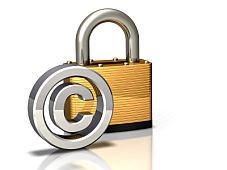17 USC 113 – Scope of exclusive rights in pictorial, graphic, and sculptural works
(a) Subject to the provisions of subsections (b) and (c) of this section, the exclusive right to reproduce a copyrighted pictorial, graphic, or sculptural work in copies under section 106 includes the right to reproduce the work in or on any kind of article, whether useful or otherwise.
Terms Used In 17 USC 113
- Common law: The legal system that originated in England and is now in use in the United States. It is based on judicial decisions rather than legislative action.
- copies: includes the material object, other than a phonorecord, in which the work is first fixed. See 17 USC 101
- Evidence: Information presented in testimony or in documents that is used to persuade the fact finder (judge or jury) to decide the case for one side or the other.
- State: means a State, the District of Columbia, the Commonwealth of Puerto Rico, or any other territory or possession of the United States. See 1 USC 7
- useful article: is a n article having an intrinsic utilitarian function that is not merely to portray the appearance of the article or to convey information. See 17 USC 101
- writing: includes printing and typewriting and reproductions of visual symbols by photographing, multigraphing, mimeographing, manifolding, or otherwise. See 1 USC 1
(b) This title does not afford, to the owner of copyright in a work that portrays a useful article as such, any greater or lesser rights with respect to the making, distribution, or display of the useful article so portrayed than those afforded to such works under the law, whether title 17 or the common law or statutes of a State, in effect on December 31, 1977, as held applicable and construed by a court in an action brought under this title.
(c) In the case of a work lawfully reproduced in useful articles that have been offered for sale or other distribution to the public, copyright does not include any right to prevent the making, distribution, or display of pictures or photographs of such articles in connection with advertisements or commentaries related to the distribution or display of such articles, or in connection with news reports.
(d)(1) In a case in which—
(A) a work of visual art has been incorporated in or made part of a building in such a way that removing the work from the building will cause the destruction, distortion, mutilation, or other modification of the work as described in section 106A(a)(3), and
(B) the author consented to the installation of the work in the building either before the effective date set forth in section 610(a) of the Visual Artists Rights Act of 1990, or in a written instrument executed on or after such effective date that is signed by the owner of the building and the author and that specifies that installation of the work may subject the work to destruction, distortion, mutilation, or other modification, by reason of its removal,
then the rights conferred by paragraphs (2) and (3) of section 106A(a) shall not apply.
(2) If the owner of a building wishes to remove a work of visual art which is a part of such building and which can be removed from the building without the destruction, distortion, mutilation, or other modification of the work as described in section 106A(a)(3), the author’s rights under paragraphs (2) and (3) of section 106A(a) shall apply unless—
(A) the owner has made a diligent, good faith attempt without success to notify the author of the owner’s intended action affecting the work of visual art, or
(B) the owner did provide such notice in writing and the person so notified failed, within 90 days after receiving such notice, either to remove the work or to pay for its removal.
For purposes of subparagraph (A), an owner shall be presumed to have made a diligent, good faith attempt to send notice if the owner sent such notice by registered mail to the author at the most recent address of the author that was recorded with the Register of Copyrights pursuant to paragraph (3). If the work is removed at the expense of the author, title to that copy of the work shall be deemed to be in the author.
(3) The Register of Copyrights shall establish a system of records whereby any author of a work of visual art that has been incorporated in or made part of a building, may record his or her identity and address with the Copyright Office. The Register shall also establish procedures under which any such author may update the information so recorded, and procedures under which owners of buildings may record with the Copyright Office evidence of their efforts to comply with this subsection.
